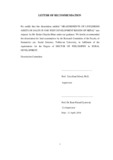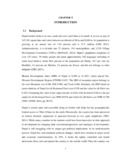Please use this identifier to cite or link to this item:
http://archive.nnl.gov.np:8080/handle/123456789/164| Title: | MEASUREMENT OF LIVELIHOOD ASSETS OF DALITS IN FAR-WESTERN DEVELOPMENT REGION OF NEPAL |
| Authors: | BHATT, KEDAR CHANDRA |
| Keywords: | Social, Economic and Political Situation of Dalits |
| Issue Date: | 24-Mar-2019 |
| Abstract: | This study was conducted for the measurement and analysis of the livelihood assets of the Dalits living in different ecological zone belonging to three districts of Far- Western Development Region (FWDR). The study has developed the major livelihoods index, their components and sub-components, and how these assets index are different from people to people based on their location of living, occupation they engaged in, and membership they possess too. The activities of the people in which they are dependent for survival are the basis of livelihood assets. The study has made further analysis of the relationship between livelihood assets, policies and programmes, vulnerability context and livelihood strategies as per the framework used for livelihood analysis. The main objectives of the study are: 1) to find out the socio-economic status and local livelihood strategies of Dalits, 2) to develop the livelihood asset index (LAI), and analyse their interrelationship; 3) to analyse public policies, plans and programmes in relation to livelihood enhancement and explore the gap; 4) to analyse the barrier factors for the better livelihood assets development of Dalits. The study was conducted in between 2011 to 2015 AD by using both qualitative and quantitative methods, and was conducted in FWDR region selecting three districts representing three ecological zone of Nepal. The livelihood asset indices were calculated based on the formula used for the development of Human Development Index (HDI). The study targeted to the Dalit community especially, focuses on FWDR The study highlighted the major determinants of livelihood assets by development of livelihood assets Index (LAI) with component index, such as human asset index (HAI), natural asset index (NAI), financial asset index (FAI), social asset index (SAI) and physical asset index (PAI). The study revealed that policy and programmes affect the livelihood assets, and consequently the livelihood assets affect the livelihood activities, which finally results in the livelihood outcomes. The weak public policies and programmes in regard to the Dalit’s development are the major barriers which have affected the livelihood assets of Dalit. The assets are core of livelihood and are affected by the weak or strong viii provision in policy addressing the need of people. Strong policy provisions imply strong asset index, which determine the strong position of an individual in society, while weak policy provisions implies the weaker position of individual which determine the vulnerability of the individual in society for living. Hence the policy provisions directly affect the livelihoods assets of the people. This indicates that Dalits have had very few assets and more vulnerability of living which in turn made them disadvantaged and excluded from the mainstream of development. The result of the study revealed that there was not positive relationship between public policies and programmes as well as the livelihood of Dalits. The result shows that the average index of livelihood asset (human, social, financial, natural and physical) has been found 0.281 value, Of the different livelihood assets, the social assets index was found to be the weakest ( 0.103) followed by financial (0.130), natural (0.379), physical (0.378) and human (0.410) asset index respectively. The research finding contradict the general assumption of people that Dalits are backwarded due to economic condition, however, social asset was found to be the main barrier for livelihood development of Dalit, as it was the weakest among other livelihood assets. Furthermore, while looking into the trends of livelihood assets and their index value, it can further be concluded that while making the national policy for addressing the need of Dalit, only social empowerment was not enough for the overall development of Dalits. Both the economic and human parameters should also be taken into consideration. Public policies and programmes were not found supportive for the abolition of untouchability related challenges which Dalits have been facing the most. In the same way, public policies and programmes were also not practicable for the conservation of their caste based traditional occupations (e.g. folk dancing and songs-Hudke, Damaha, Chhaliya dance), potter (metal), tailoring, carpentry, bamboo weaving etc.). Therefore, appropriate measures should address the diverse issues embedded with the livelihood enhancement of Dalits. |
| URI: | http://103.69.125.248:8080/xmlui/handle/123456789/164 |
| Appears in Collections: | 300 Social sciences |
Files in This Item:
| File | Description | Size | Format | |
|---|---|---|---|---|
| 1. TITLE OF THESIS FINAL 2nd JUN,, 2016.pdf | 5.1 kB | Adobe PDF |  View/Open | |
| 2.TABLE OF CONTENTS & ABSTRACT FINAL 2nd JUN, 2016.pdf | 454.51 kB | Adobe PDF |  View/Open | |
| 3. Kedar TU_final disertation 2nd JUN , 2016.pdf | 3.74 MB | Adobe PDF |  View/Open | |
| Dr. Ishwori Pd. Kadel.doc | 1.59 MB | Microsoft Word | View/Open |
Items in DSpace are protected by copyright, with all rights reserved, unless otherwise indicated.